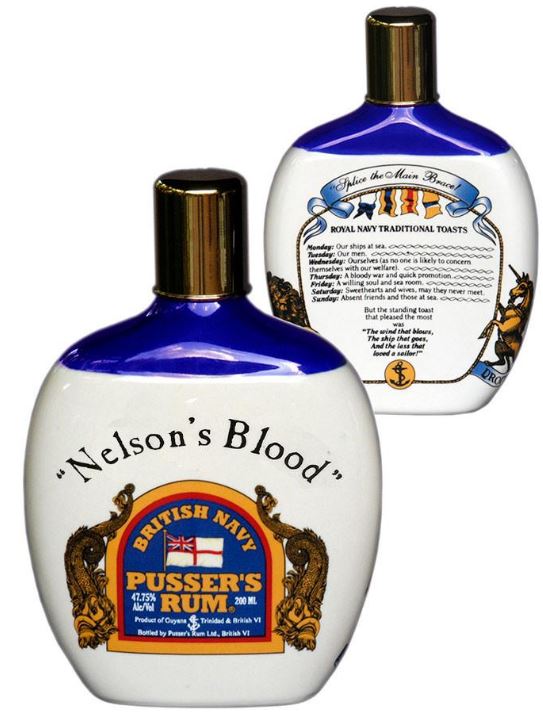
Photo (c) up-spirits.com
First posted 25 February 2010 on Liquorature.
(#012)(Unscored)
***
There’s surprisingly little hard information about Pusser’s “Nelson’s Blood” Navy Rum aside from the bare bones history and some folklore about the rum itself. For example, the bottle I bought said nothing about the age, nor did any catalogue or webpage discuss it at length except to refer to its origins. And when, as noted before, there is a scarcity of expert salespeople to discuss your selection with, well, I guess I had to take a flier and buy it based on rarity – I had never seen it before – and how much it cost. This is one of those odd times when I bought a smaller bottle simply because I didn’t know enough to make a determination of quality. The 1L bottle went at $95 and I decided to go for the 200mL at one fifth the price.
Pusser’s – the company hails from the British Virgin Islands – stakes its claim to fame on the fact that they are the inheritors of the Royal Navy tradition (this tradition is an essay all by itself and would include snippets on wets, sips, gulps and tots, grog, the scuttle butt, how rum was served to sailors and why, and how the traditon changed and was then abandoned…fascinating stuff). According to them, they use the same methods and ingredients and distil to the same strength, as the Royal Navy did for some three centuries (until the practice was abandoned in 1970). Pusser’s bought the original recipes and wooden pot-stills from the Navy in 1979 and have an extremely limited range; they seek to distinguish themselves by sticking with the old Navy method of not adding anything to the final distillation (like caramel, sugar, or other flavouring agents). This enhances the intense flavours imparted by the wooden pot-stills, which are hundreds of years old…but has the downside of making the rum less sweet, which makes mixing it a must for some.
The rum I bought, the Blue Label “Nelson’s Blood” is a slightly stronger-than-standard rum at 47.5% and as I said, I have absolutely no idea how old it is, though their slightly stronger (54%) and more expensive relative is fifteen years old, so I hazard a guess based on tasting and what little experience I have, that this one may be around eight. Now further research says that the rum I had is a blend of various aged rums, matured in used whiskey or bourbon barrels, but this would fly in the face of what Pusser’s themselves claim: all concede, however, that this about as close to standard Royal Navy rum – the way it used to be – as you are likely to get in this day and age.
Is it any good for the price? Well, yes. The nose is fairly pungent of the molasses used in its making (and all the sugar hints underneath that), but the practice of adding just about nothing to the mix makes it a stronger, more spirit-laden nose than one might expect. It’s smooth over ice – a bit too harsh neat, I think – with a shade of bite on the way down: though at 47% ABV that isn’t surprising. It lacks the richness of flavour and texture on the tongue of a better Mount Gay or Appleton 12, and this may come from the claimed lack of additives: but the thing is, there are flavours of vanilla and nutmeg to be found, and if the blenders add nothing and use the same centuries-old pot stills the Navy used, then it must be coming from generations of stills themselves. An interesting notion. The finish is medium long and of middling bite. Nothing special there, unfortunately
In summary, it’s a good sipping rum for sure, but not really sweet enough for my taste – I have a feeling whiskey lovers are going to appreciate it more than I would. I absolutely concede that for smoothness and intriguing, original taste (with or without an additive of one’s own), it deserves a place on anyone’s shelf, but if the price of a standard bottle is a bit steep, the 200ml peewee pictured above should do you just fine until you make up your own mind.
NB: “Pusser” is a bastardization of the word “Purser”, a position on ships akin to a quartermaster in the army. It was the Purser in the Royal Navy who was responsible for acquisition and distribution of the good stuff.